Gerry Adams's Blog, page 87
March 7, 2011
Changing Times
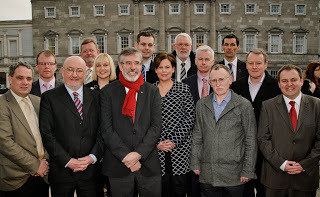
It's just over a week since this blog was elected by the people of Louth and East Meath to be their Teachta Dála.
As Fine Gael and Labour negotiated their way into government Sinn Féin's new 14 strong Dáil team met in Leinster House to begin the work of becoming the real opposition. Everyone was in great form.
We are very mindful that this is the year which marks the 30th anniversary of the hunger strike and of the sacrifice of the men and women in all of the prisons who contributed enormously to the growth and development of Sinn Féin.
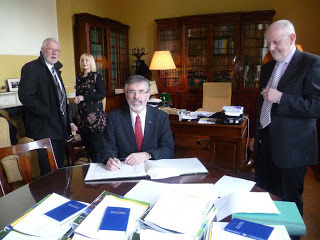
So, there was a real sense of change and of progress being made. A recognition that we are part of an all-Ireland team. A determined mood to advance our republican objectives and of confronting the bad policy decisions that will be the inevitable outworking of a Fine Gael led government. Sinn Féin is in Leinster House to do business. We are there to put backbone into the Dáil.
The reality is that the problems of unemployment and emigration, of negative equity and of cuts to welfare payments and wages, and of taxpayers money being used to pay for private bankers greed, that were all part of the backdrop to the election campaign, are still there. The universal social charge is a millstone around the neck of citizens. This charge introduced by the last government takes money out of the pockets of over one million citizens, including people on minimum wage, carers, and blind pensions.
And Fine Gael and Labour now claim that the briefings they have received from the department of Finance and others have shown them that the financial situation is worse than they were led to believe by Fianna Fáil.
They should publish any new details they have. Citizens have a right to know.
As well as the new Sinn Féin team of TDs getting together this blog spent several days last week at internal party meetings discussing organisational as well as policy issues as we prepare for the opening of the 31st Dáil. Thus far I don't have an office. Until these matters are sorted out Aengus has very kindly let me squat in his.
This week also saw the British Queen accept an invitation from President McAleese to visit the south of Ireland. Sections of the Irish media have embraced this development in a fawning and servile fashion.
This blog is a republican and is against monarchies and elites of any kind, political or religious, secular or industrial. This blog is for power for the masses and rights for the individual. People have to be sovereign. People are citizens, not subjects.
I am also very aware of the symbolism of a state visit by Queen Elizabeth of England. She and her family have been regular visits to the north over the decades. Unionists have a different attitude to the British monarchy than their nationalist and republican neighbours. For many unionists she represents their sense of who they are as British subjects. They will welcome the visit.
There will be those who will not. It will give offence to many Irish citizens, particularly victims of British rule and those with legacy issues in this state and in the North.
This blog believes President McAleese and her husband Martin have done good work. They have been especially diligent in connecting to Irish citizens living in the north and in reaching out to unionists. Unionist visitors to Áras an Uachtaráin are now commonplace.
It is evidence that we are living in changed and changing times.
Sinn Féin is in the leadership of this process of change. We are for the normalisation of relationships between the people of these islands, based upon mutual respect and equality.
However this blog believes that the invitation to the English Queen and the visit are premature. There are many issues of concern which remain unresolved, including the partition of Ireland and those legacy matters which I mentioned at the beginning of this blog. Yes, the Good Friday Agreement provides a means for resolving all of these but much progress still needs to be made.
Published on March 07, 2011 14:01
March 4, 2011
Memories of the H Blocks
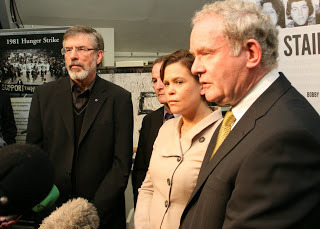
The legacy and memories of the H Blocks of Long Kesh were very present this week for this blog. On Monday, in my first official role as a TD for Louth and East Meath I spoke at the removal from Dundalk of my good friend and comrade and H-Block escapee Peter 'Skeet' Hamilton.
The next day was the 30th anniversary of the 1981 hunger strike and along with other ex-prisoners and family members I was present in the Linen Hall Library in Belfast for the opening of an exhibition marking the hunger strike.
Martin McGuinness and Mary Lou McDonald formally launched the exhibition.
It is a remarkable collection of photos and memorabilia of that time. It sets the prison struggle in the context of the wider freedom struggle, the British criminalisation policy and events inside and outside of the prison.
It includes original comms written by Bobby Sands, Ciaran Doherty and Mairead Farrell and others, on tiny pieces of paper which were smuggled out of the H-Blocks and Armagh women's prison.
H-Block and Armagh prisoners were denied reading material, newspapers, radios, television, books and any mental stimulation. The object was to break their spirit. It was also an effort to impose an extreme form of isolation to break the prisoners and to convince them that they were alone, that no one cared.
But republican prisoners found innovative ways around the brutal and harsh regime of the prisons.
This blog remembers once upon a time in the cages that an elaborate system of coded semaphore signals was developed. This involved a prisoner standing precariously on a chair, on top of a table, on top of a hut, ands using small flags to send messages to another prisoner similarly precariously balanced in another part of the jail.
In the H Blocks the favoured method for sending messages was comms. Tiny pieces of paper, usually cigarette roll-up paper or bits of the bible were the favoured material, covered in cling film and swung on lines outside windows between cells or under doors. Comms were also smuggled in and out of the prison despite harsh searches for prisoners and their visitors.
Prisoners endured beatings and degrading mirror searches as the prison system tried to cut communication as well as break the prisoner's morale.
One unique method adopted by the prisoners was the use of small crystal radios that were made on the outside and smuggled into the Blocks so that the prisoners could listen to the news and keep up to date with developments.
Their existence was a closely guarded secret. But on display in the new exhibition is the 'Maggie Taggert' a small crystal radio that was used by the prisoners. It was so-named after a BBC reporter who was frequently on the radio at that time.
Mrs Dale was another code-name – Mrs Dale's Diary being a long time BBC radio programme.
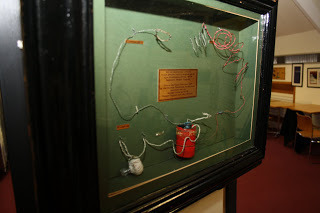
Maggie Taggert Radio
The exhibition is the work of the National Hunger Strike Committee and is available for display. It will be travelling across the island in the course of this year but anyone interested in displaying it in their local area should contact the committee through its email hungerstrike@sinn-fein.ie
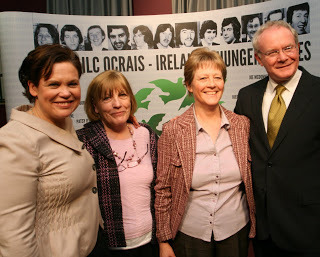
Francie Hughes sisters Vera and Dolores
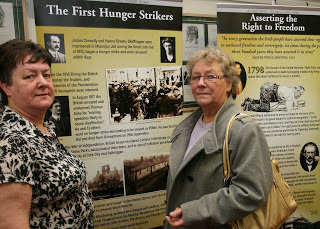
Joe McDonnell's sisters Maura and Eilish
Peter Hamilton
Peter Hamilton was in the cages during the hunger strike. His dedication, loyalty, and activism over 40 years of struggle is the stuff of legend. Hundreds gathered in bright sunshine in Dundalk on Monday afternoon to pay their respects. And many more attended his funeral in Belfast on Thursday.
Peter came at his republicanism and life in the same way that he tackled his illness. He refused to allow it to depress or get him down.
Two weeks ago his friends organised an event for him in the Star in Ardoyne.
Friends and comrades from far and wide came to demonstrate their solidarity with Peter and to enjoy the craic.
In the Star he joked that he was the only one he ever knew who went into Drogheda hospital with a hernia and came out with cancer.
Peter was from Ardoyne and hugely proud of his local area. Like many others he had been influenced by the pogroms of 1969 in which unionists mobs had burned out whole streets in Ardoyne. Peter joined the IRA.
He was a fearless and determined republican activist. Later he was arrested and spent several years in Crumlin Road prison and then in the cages of Long Kesh before his release in early 1975.
Peter returned to the struggle and in the summer of 76, along with Bik McFarlane and Seamus Clark he was back in the cages. That's where I met him for the first time. I had been sentenced for trying to escape from internment and Skeet was arriving in for his second time in the cages.
Peter ended up in the middle hut along with Cleaky, Big Deuce and Moke – all of them have now died from cancer, a cause for concern for many former political prisoners and sourced by some to the use of CR gas by the British Army in October 1974 when Long Kesh was burned down.
Peter was full of energy, was hilarious company and helped make the hard time go easier. He was always looking for ways to escape. He was involved in the digging of more than one tunnel.
And in 1982 himself and Gerry Kelly, Francis McIlvenna and Ned Maguire succeeded in getting outside of their cage but they were caught before they could exit stage left. Or right.
They were transferred to the H Blocks where a year later Peter played a key role in the great escape of 1983. He was one of those who had the job of securing the Block. He was recaptured along with Big Bobby, Sean McGlinchey and Joe Simpson hiding in the river and all three were among those who were viciously beaten afterward.
Peter was eventually released. Between his two periods of incarceration he spent almost 20 years in prison.
He was totally behind the peace strategy. And when I visited him in Drogheda hospital during the election campaign he told me not to worry that I would be elected. And he was determined to play his part in that. On polling day he went to the polling station when it opened and cast his vote. Then he went home and died.
Peter was a solid republican activist who demonstrated time and time again, and not least when he was ill, great strength of character.
On behalf of all those who had the honour to know him and the many republicans who didn't this blog extends sincerest sympathies to his brother Denny and sisters Mary and Eileen and especially his sister Kathleen who looked out for him through all his years in prison and from whose home he was waked and buried.
I also want to thank all of Peter's friends in Dundalk who were with him through his long illness and who looked after him. Especially Mackers.
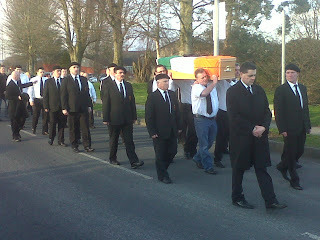
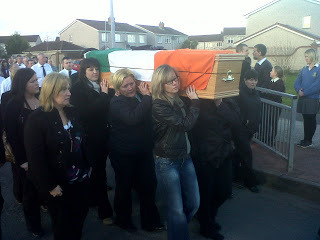
Published on March 04, 2011 16:57
March 1, 2011
A democratic revolution
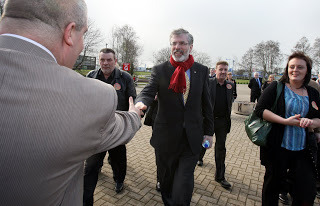
Arriving at the Count in Dundalk
The election is now finally and positively and definitively over! The last counts in Wicklow and Laois Offaly and Galway West have been completed and the shape of the next Dáil is now known.
Acres of newsprint have been used to analyse the results and hours of television and radio, of tweets and blogs have reported on every twist and turn of what was a hugely important election.
Fianna Fáil and the Green Party have been punished for the bad decisions they took in government. Fine Gael and Labour benefited from the public anger. They did so despite having said they will implement Fianna Fail's policy of adding private banking debt to the sovereign debt, and of implementing a succession of punitive austerity budgets over the next three years at least.
There are a plethora of independents from the left to the right and many in between.
And there are 14 Sinn Fein Teachtaí Dála! The largest number of Sinn Féin TDs in Leinster House since partition.
As a result of this election 220,660 or 10% of the electorate in the south voted Sinn Féin.
Together with the votes Sinn Féin secured in the north it means that in the last 12 months 392,633 people have voted across the 32 counties for Sinn Féin. That makes this party the third largest on the island.
The final count which saw Brian Stanley take that final 14th seat fittingly concluded on March 1st the 30th anniversary of the commencement by Bobby Sands of the 1981 hunger strike.
The hunger strike shaped the course of Irish politics in the subsequent decades.
The success of Bobby's election in Fermanagh South Tyrone in the Westminster election of April 81, and of Ciaran Doherty in Cavan Monaghan and Paddy Agnew in Louth in the June 81 general election in the south, were watershed moments.
None of us knew that at the time. Some of us felt it instinctively but it has needed the intervening decades to understand the extent to which the courage and sacrifice of the ten men who died on hunger strike changed modern Irish history.
For Sinn Féin it was the acceleration of a process of internal debate which saw the party embrace electoralism. And it was the commencement of a conversation which ultimately led to the party's peace strategy and the peace process.
In the south it was the end of majority government by a single party. From 1981 coalition government was the order of the day with a succession of parties, including Labour, the PDs and the Greens stepping forward to put Fianna Fáil or Fine Gael into government. And all paid an electoral price.
It was also the beginning of the slow decline of Fianna Fáil as the dominant political force in that part of the island.
Aside from the 14 who were elected this weekend there were others who did well have laid a good foundation for the future. Some candidates missed by handfuls. John Brady, Katherine and Eoin.
The political strategy to achieve our republican goals is not an easy one. The process is inevitably slow and incremental, it has its up and downs, but it is working.
Our task in the time ahead is to build on the gains that have been made.
It means building on the all-Ireland dimension, the institutions, agencies and structures created by the Good Friday Agreement.
Sinn Féin will be a constructive opposition.
That means campaigning on issues that oppress working families from the universal social charge to cuts in health and education, to defending jobs.
It means knowing who we are and what we represent. Opposing a bad government in Dublin while governing effectively in the north.
Sinn Féin is an Irish republican party. We are in the business of achieving a United Ireland. A new republic, based on the principles and values contained in the 1916 Proclamation and the Programme of the First Dáil.
Republicans are about building a new Ireland which embraces men and women, those of every religion and none, those who are orange and those who are green and those who have come to our shores in recent times.
We seek a new Ireland built on genuine republican values of equality and fairness.
We are not rhetorical republicans. We don't just sing or dream or make fine speeches about a united Ireland – though all of these are important and have their place in that enterprise – we are the doers, the activists, the strategists and planners.
We are the people who believe in citizenship and citizens rights and who understand that a real republic must look after every member of society – not just elites and the rich and powerful.
To achieve these goals republicans have to build political strength and then use that strength wisely and appropriately.
In the north Sinn Féin is the largest party in terms of votes and the second largest in terms of seats in the Assembly.
In the south there is now a strong cadre of political activists about to enter Leinster House and a strong and growing Sinn Féin organisation across the state.
Everything these elected representatives do, at Stormont or Leinster House, in local councils or the European Parliament and in communities must be about advancing our united Ireland project while defending peoples rights and improving the quality of life for citizens.
In the last weeks of the election campaign hundreds of emails flooded our offices from people wanting to join Sinn Féin.
The republican strategy is taking shape. Republican politics are changing Ireland. Republican politics are working.
As we approach the 100th anniversary of the 1916 Rising there is hope that this generation of republicans can bring about a democratic revolution and achieve the objectives set out for us almost 95 years ago on Easter Monday 1916. Join us in that historic endeavour.

Published on March 01, 2011 17:25
February 26, 2011
Corruption
'It's all over bar the voting' said Your Man.
That's the most important part of the exercise – the people voting. We are in Drogheda. It's a nice day. It is also the peoples day. Tomorrow the process of counting the votes will begin. Some results may not be known until Monday but the general shape of the next Dáil – the 31st Dáil - will emerge quickly.
It's been an exhausting, informative, and at times very enjoyable election campaign. This blog wants to thank all of those from far and near who expressed their support and solidarity to me on my travels around Louth and the rest of the state. Some directly on the streets and up the long lanes and byways and some via facebook, blog and email. Go raibh maith agaibh uilig.
One of the memorable moments of the campaign for this blog was in the course of a debate on LMFM radio – that's Louth Meath FM radio for the non locals – when this blog said that the southern state wasn't a real republic.
The other candidates began jumping up and down on their seats in indignation. But the fact is that by the standards set in the Proclamation which defines the republic, this state falls far short.
This blog drew their attention to the huge levels of poverty and inequality, of unemployment and inadequate housing and of a second rate health and education systems and much more. And in particular of the elites and the golden circle who have run the state for decades in their interests and not those of the people. And the lack of sovereignty. And partition. These are not the values set down in the Proclamation.
A worse reaction was encountered when at the launch of our party election campaign this blog described the political system as corrupt. Some of the journalists reacted as if I had slapped them on the face and demanded to know on what grounds I made such accusations and cross examined me on my definition of corruption?
It was an interesting insight into the mindset of some. Many of these same journalists have covered countless stories of brown envelope backhanders, of planning corruption, of political cronyism and Tribunals in which the high and mighty in politics have been exposed as corrupt.
Moreover things are now so bad that the other parties – from Fianna Fáil, through Labour and Fine Gael and the Greens have published detailed proposals on the reform of the system. Why? Because they know it's corrupt and they know that citizens know it's corrupt and want change. But now after years of having sipped from the same trough they are falling over themselves in bringing forward reform proposals.
The word corruption has two principal meanings: 1. Immoral or evil; 2. Influenced by or using bribery.
Establishment politics in the south has been marked by essentially immoral policy decisions - decisions that reward the excessively wealthy and punish the poor.
The relationship between establishment politicians and developers and speculators has been shown to be corrupt. Witness Ray Burke (FF) and Charlie Haughey (FF) and there have been others from other parties.
There has been both personal corruption - i.e. receiving backhanders from developers etc. - and political corruption.
Political corruption is where politics is corrupted by elected representatives who allow privileged elites - industrialists, bankers, developers, speculators - to wield undue influence on policy decisions, adversely affecting ordinary citizens. This was the type of corrupt influence that inflated the property bubble - putting families in massive mortgage debt but enriching developers and ultimately sinking the economy.
Whole armies of lawyers and accountants worked day and night to exploit exemptions in the tax system to ensure their clients paid as little tax as possible.
Laws to provide more social and affordable housing, to integrate our communities, were cast aside when the developers and the property speculators objected.
It was illegal in the 1980s for councillors in County Dublin to accept bribes to rezone land. That didn't stop some of them. Who benefitted? Property developers. And the corrupt councillors.
But in the 1990s and 2000s Finance Minister Charlie McCreevy brought in all kinds of property-based tax reliefs that deprived the public of untold millions in revenue - the full cost will never be known - and allowed developers and speculators to line their pockets. This was all perfectly legal but it was still corrupt.
The corrupt influence continues. For example, the proposed abolition of Section 23 property-based tax relief in the 2011 Finance Act has been put on hold so that an economic impact analysis could be done. There was no such freeze on the regressive Universal Social Charge to assess its crippling impact on low to middle income families and local economies.
Freedom of Information legislation was weakened and undermined because some in power do not accept the right of citizens to know how their state operates.
The rights of our citizens to decent housing or accessible healthcare became favours to be granted, or strokes to be pulled, in exchange for votes.
In the most extreme example, public officials and representatives were found to have taken bribes.
What all of these have in common is that the public good, the best interests of the people of this state, took second place to private interest. This is the corruption in Irish society, the legacy of government by and for vested interests.
Those who are convicted of corrupt planning practices will be held accountable for that, though not for the problems their decisions helped to create in poorly planned communities around Ireland.
But what about those who broke no laws? It's not against the law to look after the developers before the families on housing waiting lists, or the bankers before those on social welfare. But it is a corruption of the notion of republican democracy, a breach of trust, one that as republicans we must confront at every opportunity.
Hopefully today's election will signal the beginning of the end of corruption in Ireland and the start of a realignment of our politics. North and South there was never a greater need for genuine republican politics.
That's the most important part of the exercise – the people voting. We are in Drogheda. It's a nice day. It is also the peoples day. Tomorrow the process of counting the votes will begin. Some results may not be known until Monday but the general shape of the next Dáil – the 31st Dáil - will emerge quickly.
It's been an exhausting, informative, and at times very enjoyable election campaign. This blog wants to thank all of those from far and near who expressed their support and solidarity to me on my travels around Louth and the rest of the state. Some directly on the streets and up the long lanes and byways and some via facebook, blog and email. Go raibh maith agaibh uilig.
One of the memorable moments of the campaign for this blog was in the course of a debate on LMFM radio – that's Louth Meath FM radio for the non locals – when this blog said that the southern state wasn't a real republic.
The other candidates began jumping up and down on their seats in indignation. But the fact is that by the standards set in the Proclamation which defines the republic, this state falls far short.
This blog drew their attention to the huge levels of poverty and inequality, of unemployment and inadequate housing and of a second rate health and education systems and much more. And in particular of the elites and the golden circle who have run the state for decades in their interests and not those of the people. And the lack of sovereignty. And partition. These are not the values set down in the Proclamation.
A worse reaction was encountered when at the launch of our party election campaign this blog described the political system as corrupt. Some of the journalists reacted as if I had slapped them on the face and demanded to know on what grounds I made such accusations and cross examined me on my definition of corruption?
It was an interesting insight into the mindset of some. Many of these same journalists have covered countless stories of brown envelope backhanders, of planning corruption, of political cronyism and Tribunals in which the high and mighty in politics have been exposed as corrupt.
Moreover things are now so bad that the other parties – from Fianna Fáil, through Labour and Fine Gael and the Greens have published detailed proposals on the reform of the system. Why? Because they know it's corrupt and they know that citizens know it's corrupt and want change. But now after years of having sipped from the same trough they are falling over themselves in bringing forward reform proposals.
The word corruption has two principal meanings: 1. Immoral or evil; 2. Influenced by or using bribery.
Establishment politics in the south has been marked by essentially immoral policy decisions - decisions that reward the excessively wealthy and punish the poor.
The relationship between establishment politicians and developers and speculators has been shown to be corrupt. Witness Ray Burke (FF) and Charlie Haughey (FF) and there have been others from other parties.
There has been both personal corruption - i.e. receiving backhanders from developers etc. - and political corruption.
Political corruption is where politics is corrupted by elected representatives who allow privileged elites - industrialists, bankers, developers, speculators - to wield undue influence on policy decisions, adversely affecting ordinary citizens. This was the type of corrupt influence that inflated the property bubble - putting families in massive mortgage debt but enriching developers and ultimately sinking the economy.
Whole armies of lawyers and accountants worked day and night to exploit exemptions in the tax system to ensure their clients paid as little tax as possible.
Laws to provide more social and affordable housing, to integrate our communities, were cast aside when the developers and the property speculators objected.
It was illegal in the 1980s for councillors in County Dublin to accept bribes to rezone land. That didn't stop some of them. Who benefitted? Property developers. And the corrupt councillors.
But in the 1990s and 2000s Finance Minister Charlie McCreevy brought in all kinds of property-based tax reliefs that deprived the public of untold millions in revenue - the full cost will never be known - and allowed developers and speculators to line their pockets. This was all perfectly legal but it was still corrupt.
The corrupt influence continues. For example, the proposed abolition of Section 23 property-based tax relief in the 2011 Finance Act has been put on hold so that an economic impact analysis could be done. There was no such freeze on the regressive Universal Social Charge to assess its crippling impact on low to middle income families and local economies.
Freedom of Information legislation was weakened and undermined because some in power do not accept the right of citizens to know how their state operates.
The rights of our citizens to decent housing or accessible healthcare became favours to be granted, or strokes to be pulled, in exchange for votes.
In the most extreme example, public officials and representatives were found to have taken bribes.
What all of these have in common is that the public good, the best interests of the people of this state, took second place to private interest. This is the corruption in Irish society, the legacy of government by and for vested interests.
Those who are convicted of corrupt planning practices will be held accountable for that, though not for the problems their decisions helped to create in poorly planned communities around Ireland.
But what about those who broke no laws? It's not against the law to look after the developers before the families on housing waiting lists, or the bankers before those on social welfare. But it is a corruption of the notion of republican democracy, a breach of trust, one that as republicans we must confront at every opportunity.
Hopefully today's election will signal the beginning of the end of corruption in Ireland and the start of a realignment of our politics. North and South there was never a greater need for genuine republican politics.
Published on February 26, 2011 00:31
February 22, 2011
Make A Stand
As Fridays General Election approaches this blog was reflecting on other elections and in particular on next Tuesday's, March 1st, 30th anniversary of the commencement of the 1981 hunger strike in which ten Irish republican prisoners died.
That year was a defining one in recent Irish history for all sorts of reasons, and elections north and south played a major part in the campaign in support of the prisoners and had huge implications for the future.
This blogs first experience of elections was shoving election literature into envelopes for the republican candidate Billy McMillan in 1964 when this blog was still at school.
However the first election in which I had an organisational and leadership role was when my friend and comrade Bobby Sands, who had begun his hunger strike on March 1st, was nominated at the end of that month to fight the Fermanagh South Tyrone seat after the sudden death of Frank Maguire.
For the duration of that campaign this blog and other activists criss-crossed Fermanagh South Tyrone urging the electorate to make a stand in support of the political prisoners.
For the last few weeks I have been criss crossing helter skelter across the south asking people once again to make a stand – but this time for themselves. The results of this election will be clear by Sunday next.
The results of the Bobby Sands election in April 1981 and the subsequent general election in the south a month later, were destined to change the shape of modern Irish politics.
Bobby was elected with a larger vote than the British Prime Minister Margaret Thatcher whose intransigent stance led to the hunger strike. The success of that election and a subsequent by-election victory accelerated a significant debate within Sinn Féin on the benefits of fighting elections.
This was given added weight by other successful electoral interventions in the south. Kieran Doherty was elected as a TD for Cavan Monaghan and Paddy Agnew was elected for the Louth constituency in the June 81 general election. The intervention of H Block and Armagh women candidates, in these and other constituencies, contributed to the worst result for Fianna Fáil in 20 years.
Following the election the formation of a Fine Gael/Labour coalition spelt the end of single party government in the south and saw the start of the slow decline in Fianna Fáil's popular support.
But 30 years ago we knew none of this. We were all very mindful of the first hunger strike which had ended just before Christmas 1980 and the failure of the British to use that opportunity to resolve the prison issues.
We were conscious of the history of hunger strike in Ireland and of the names of Thomas Ashe… Terence MacSwiney… Sean McCaughey... Michael Gaughan... Frank Stagg and others who had died on hunger strike.
In his prison diary on the first day of his hunger strike Bobby set the context for it all. He wrote about his 'deeply rooted and unquenchable desire for freedom.' And he added; 'I am dying not just to attempt to end the barbarity of H Block, or to gain the rightful recognition of a political prisoner, but primarily because what is lost in here is lost for the republic ...'
Over a gruelling seven-month period, ten courageous Irish men - Bobby, Francis, Raymond, Patsy, Joe, Martin, Kevin, Kieran, Thomas and Mickey - laid down their lives, one after the other, attesting to the world the strength of their convictions in a battle of wills with the powerful British state, epitomised in the shrill voice of Thatcher.
Though the prisoners lost their lives, the British government lost the battle of criminalisation. Indeed it lost much more because the hunger strike catapulted a whole new generation of men and women into the struggle for freedom.
It has been remarked that three decades after their deaths far from fading, the memories of 'the ten' continue to grow in stature, continue to have an impact and continue to inspire republicans throughout Ireland.
The hunger strike of 1981 now takes its place in our annals alongside Easter Week 1916, such is the power of its legacy, such is the emotion it generates, and such is the vision which it inspires.
And among the many words which emerged from that time of repression and resistance none are more powerful or lasting or relevant to today than those of Bobby's poem, The Rhythm of Time.
The Rhythm Of Time
There's an inner thing in every man,
Do you know this thing my friend?
It has withstood the blows of a million years,
And will do so to the end.
It was born when time did not exist,
And it grew up out of life,
It cut down evil's strangling vines,
Like a slashing searing knife.
It lit fires when fires were not,
And burnt the mind of man,
Tempering leadened hearts to steel,
From the time that time began.
It wept by the waters of Babylon,
And when all men were a loss,
It screeched in writhing agony,
And it hung bleeding from the Cross.
It died in Rome by lion and sword,
And in defiant cruel array,
When the deathly word was 'Spartacus'
Along the Appian Way.
It marched with Wat the Tyler's poor,
And frightened lord and king,
And it was emblazoned in their deathly stare,
As e'er a living thing.
It smiled in holy innocence,
Before conquistadors of old,
So meek and tame and unaware,
Of the deathly power of gold.
It burst forth through pitiful Paris streets,
And stormed the old Bastille,
And marched upon the serpent's head,
And crushed it 'neath its heel.
It died in blood on Buffalo Plains,
And starved by moons of rain,
Its heart was buried in Wounded Knee,
But it will come to rise again.
It screamed aloud by Kerry lakes,
As it was knelt upon the ground,
And it died in great defiance,
As they coldly shot it down.
It is found in every light of hope,
It knows no bounds nor space
It has risen in red and black and white,
It is there in every race.
It lies in the hearts of heroes dead,
It screams in tyrants' eyes,
It has reached the peak of mountains high,
It comes searing 'cross the skies.
It lights the dark of this prison cell,
It thunders forth its might,
It is 'the undauntable thought', my friend,
That thought that says 'I'm right!'
That year was a defining one in recent Irish history for all sorts of reasons, and elections north and south played a major part in the campaign in support of the prisoners and had huge implications for the future.
This blogs first experience of elections was shoving election literature into envelopes for the republican candidate Billy McMillan in 1964 when this blog was still at school.
However the first election in which I had an organisational and leadership role was when my friend and comrade Bobby Sands, who had begun his hunger strike on March 1st, was nominated at the end of that month to fight the Fermanagh South Tyrone seat after the sudden death of Frank Maguire.
For the duration of that campaign this blog and other activists criss-crossed Fermanagh South Tyrone urging the electorate to make a stand in support of the political prisoners.
For the last few weeks I have been criss crossing helter skelter across the south asking people once again to make a stand – but this time for themselves. The results of this election will be clear by Sunday next.
The results of the Bobby Sands election in April 1981 and the subsequent general election in the south a month later, were destined to change the shape of modern Irish politics.
Bobby was elected with a larger vote than the British Prime Minister Margaret Thatcher whose intransigent stance led to the hunger strike. The success of that election and a subsequent by-election victory accelerated a significant debate within Sinn Féin on the benefits of fighting elections.
This was given added weight by other successful electoral interventions in the south. Kieran Doherty was elected as a TD for Cavan Monaghan and Paddy Agnew was elected for the Louth constituency in the June 81 general election. The intervention of H Block and Armagh women candidates, in these and other constituencies, contributed to the worst result for Fianna Fáil in 20 years.
Following the election the formation of a Fine Gael/Labour coalition spelt the end of single party government in the south and saw the start of the slow decline in Fianna Fáil's popular support.
But 30 years ago we knew none of this. We were all very mindful of the first hunger strike which had ended just before Christmas 1980 and the failure of the British to use that opportunity to resolve the prison issues.
We were conscious of the history of hunger strike in Ireland and of the names of Thomas Ashe… Terence MacSwiney… Sean McCaughey... Michael Gaughan... Frank Stagg and others who had died on hunger strike.
In his prison diary on the first day of his hunger strike Bobby set the context for it all. He wrote about his 'deeply rooted and unquenchable desire for freedom.' And he added; 'I am dying not just to attempt to end the barbarity of H Block, or to gain the rightful recognition of a political prisoner, but primarily because what is lost in here is lost for the republic ...'
Over a gruelling seven-month period, ten courageous Irish men - Bobby, Francis, Raymond, Patsy, Joe, Martin, Kevin, Kieran, Thomas and Mickey - laid down their lives, one after the other, attesting to the world the strength of their convictions in a battle of wills with the powerful British state, epitomised in the shrill voice of Thatcher.
Though the prisoners lost their lives, the British government lost the battle of criminalisation. Indeed it lost much more because the hunger strike catapulted a whole new generation of men and women into the struggle for freedom.
It has been remarked that three decades after their deaths far from fading, the memories of 'the ten' continue to grow in stature, continue to have an impact and continue to inspire republicans throughout Ireland.
The hunger strike of 1981 now takes its place in our annals alongside Easter Week 1916, such is the power of its legacy, such is the emotion it generates, and such is the vision which it inspires.
And among the many words which emerged from that time of repression and resistance none are more powerful or lasting or relevant to today than those of Bobby's poem, The Rhythm of Time.
The Rhythm Of Time
There's an inner thing in every man,
Do you know this thing my friend?
It has withstood the blows of a million years,
And will do so to the end.
It was born when time did not exist,
And it grew up out of life,
It cut down evil's strangling vines,
Like a slashing searing knife.
It lit fires when fires were not,
And burnt the mind of man,
Tempering leadened hearts to steel,
From the time that time began.
It wept by the waters of Babylon,
And when all men were a loss,
It screeched in writhing agony,
And it hung bleeding from the Cross.
It died in Rome by lion and sword,
And in defiant cruel array,
When the deathly word was 'Spartacus'
Along the Appian Way.
It marched with Wat the Tyler's poor,
And frightened lord and king,
And it was emblazoned in their deathly stare,
As e'er a living thing.
It smiled in holy innocence,
Before conquistadors of old,
So meek and tame and unaware,
Of the deathly power of gold.
It burst forth through pitiful Paris streets,
And stormed the old Bastille,
And marched upon the serpent's head,
And crushed it 'neath its heel.
It died in blood on Buffalo Plains,
And starved by moons of rain,
Its heart was buried in Wounded Knee,
But it will come to rise again.
It screamed aloud by Kerry lakes,
As it was knelt upon the ground,
And it died in great defiance,
As they coldly shot it down.
It is found in every light of hope,
It knows no bounds nor space
It has risen in red and black and white,
It is there in every race.
It lies in the hearts of heroes dead,
It screams in tyrants' eyes,
It has reached the peak of mountains high,
It comes searing 'cross the skies.
It lights the dark of this prison cell,
It thunders forth its might,
It is 'the undauntable thought', my friend,
That thought that says 'I'm right!'
Published on February 22, 2011 21:30
February 19, 2011
Paying rent to the British for Leaders Graves
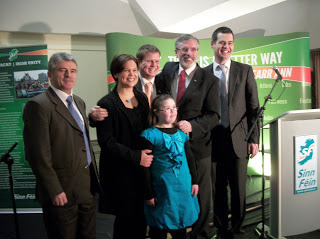
The general election in the south of Ireland has entered its final week. This blog has tramped the byways and streets and lanes in many previous campaigns in this part of the country, including in local government, EU referendum and Dáil elections.
Many years ago I campaigned in Louth when Paddy Agnew was the H-Block candidate and more recently for Arthur Morgan.
But this is my first time as a candidate. Consequently the perspective is quite different.
This blog is also used to drawing the fire of political opponents and others. That goes with the territory. But this time it took on an added intensity. Probably because as the FFers and Labour have been squeezed in the opinion polls – and this blog doesn't take any great interest in such polls – they have each become increasingly desperate to prevent their votes slipping away toward Sinn Féin.
This is one reason why Micheál Martin decided to let loose on this blog on the issue of the IRA. Elements of the media joined in also.
Regular readers will remember that when I announced my candidature for Louth and East Meath I warned there would be a tsunami of media and political vitriol. So, no surprises there.
The big issue in the campaign is the economy. And understandably so. It is in a mess. 440,000 people out of work. Thousands more jobs at risk. A thousand people, mainly young people, leaving the state every week.
The FFers and the Greens oversaw the collapse of the financial system and the banks. They then concocted a banking bailout with the IMF and the EU that will bankrupt the state if it is allowed to stand. They have heaped billions of private bankers debt on to the taxpayer. We cannot afford it.
The other main opposition parties, Fine Gael and Labour, have said they will implement this bailout. Budget 2011 contained €6 billion in cuts. All of them have agreed to a series of additional budgets which will further impoverish working families in this state in the years ahead.
While the crisis in the economy is understandably the most pressing issue at this time, fundamental political reform and the creation of a 21st century fit for purpose political system is also absolutely essential.
Did you know that nearly a hundred and fifty years after the land war there are thousands of citizens who still pay rent to abstentee landlords. And to its shame, almost 100 years after the Rising and the Proclamation of the Republic at Easter 1916, the Irish government is still paying rent on iconic state buildings, including Government Buildings, and Arbour Hill where the 1916 leaders are buried. For what died the sons of Roisin?
These ground rents should be abolished.
But all of this is a mark of the failure of the political system in Dublin. It has failed the people in so many ways. It is unaccountable and protects those who have abused public office.
This blog believes there is widespread public support for fundamental political and constitutional reform, including reform of local government.
Many of those entitled to vote do not do so, particularly young people and those from disadvantaged backgrounds. This must change.
Many of the changes Sinn Féin advocates in the south could also be applied in the north. For example there should be automatic registration for voters, the voting age should be reduced to 16, there should be a focus on voter education and the right to vote should be extended to Irish citizens living and working abroad.
Sinn Féin would also establish an all-Ireland Constitutional Forum to bring forward proposals to amend the Irish constitution so that it is fully reflective of the values and aspirations of the Irish people today. And a template for a future 32-county Republic.
This would draw upon the equality provisions in the Good Friday Agreement to safeguard citizens' rights and should be soundly based on democratic principles and international human rights standards. This would be put to the people in referendum.
Reform must focus on ensuring that political institutions are inclusive, accessible and accountable.
If you want to see political opportunism in action the reader need look no further than at the eagerness with which political parties, who happily worked and milked the system for years without considering reform, are now falling over themselves trying to convince the electorate that they really are serious about changing the system.
They all failed to do so when they had the chance.
The reality is that those in power have always protected their own interests. The citizens of this state deserve political reform, full rights,equality and fairness – that is what Sinn Féin is committed to delivering.
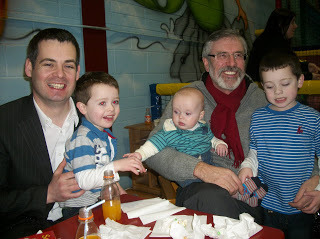
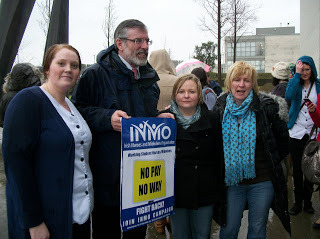
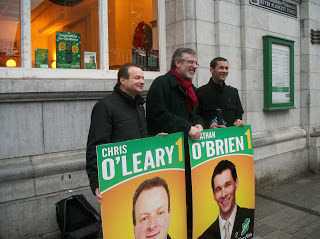
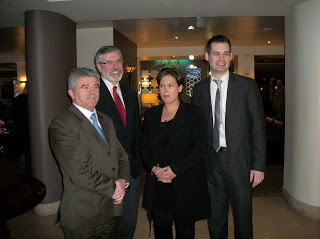
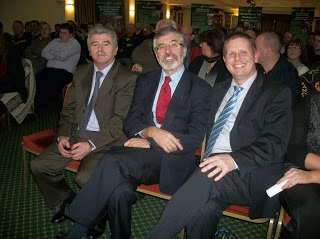
Published on February 19, 2011 16:22
February 17, 2011
State colluded in Clerical Abuse
There has been an avalanche of exposes in recent years of scandals in Church and state. Clerical sex abuse, the mistreatment of children in the industrial school system and the failure of the state to prevent all of this and to protect victims, has caused great distress.
Citizens have been bombarded by tragic accounts of children whose childhood was brutally stolen by predatory clerics, and of vulnerable adults, especially young girls and women reduced to the status of slaves in some Catholic Church institutions.
As the Ryan Report revealed great hurt was inflicted in the name of social conformity and religious doctrine. The Irish state was complicit in this.
But the Catholic Church was not the only Church which ran institutions, in association with the state, and which abused children and adults.
Niall Meehan, an academic researcher from Griffith College in Dublin has written extensively about the horrifying litany of abuse which took place in Bethany Home in Rathgar, in south Dublin, in the period 1922 to 1972.
Bethany Home was run by an independent protestant group as an evangelical institution for unmarried mothers and their children. It also took in prostitutes, alcoholics, and young people under 17. Women and young people convicted in the courts were also sent there. In 1945 the Church of Ireland Archbishop of Dublin recommended it as a place of detention.
Bethany's management committee included clergy who were part of a Church of Ireland body whose objective was to convert Catholics – the Society of Irish Church Missions to the Roman Catholics (ICM-RC).
After February 1935 management committee members had to sign a 'Doctrinal Pledge'. It declared 'the utter depravity of human nature ... and the eternal punishment of the wicked.'
Nursing staff had to be evangelical missionaries.
Thus far it has been established that at least 219 children died between 1922 when the Home opened and 1949, two-thirds between 1935-44. They were buried in unmarked graves. Some died from marasumus – a form of malnutrition.
As Niall Meehan has said: 'A desire to save more souls accompanied inadequate provision for the bodies they inhabited.'
In 1939 reports from St. Ultan's and the Coombe Hospitals revealed that children from Bethany suffered from a range of medical problems including, rickets, scalding, whooping coughs and conjunctivitis.
The failure of the Irish state to properly monitor and manage conditions in Bethany was exposed in reports by the then Deputy Chief Medical Adviser. He explained away neglect criticised by his own inspectors and higher than average mortality by claiming that 'it is well recognised that a large number of illegitimate children are delicate ... '
Another aspect of Bethany's function was the export of children to similar organisations in England, including Barnardo's; the Salvation Army and Fegan's Homes for Boys. From these and from Catholic organisations many children were then transferred on to colonies of the British Empire. Many were sent direct from the north of Ireland. Fegan's for example, described itself as a 'Protestant, evangelical undenominational' home. It advertised the fact that it received 'destitute and orphan boys to educate and train in farm work for migration to Canada'.
Under the Empire Settlement Act of 1922 the British government could pay up to 50% of the cost of transporting a child to one of its colonies. By 1931 Barnardo's had deported 30,000, almost one third of the 100,000 children transplanted by that time. Many of these children were simply stolen from their parents who were told they were dead or adopted. The children who were never adopted were told similar lies.
The Imperialist mindset which underpinned all of this is evident in a letter carried in the London Times in April 1928 in which David C Lamb the Commissioner of the Salvation Army said 'it is particularly refreshing to find Australia is keeping her doors wide open, and, at the same time, is, of course, taking every reasonable precaution to build imperially by selecting children coming from a clean, healthy British stock.'
The exploitation, physical and sexual abuse these stolen children received was horrendous. A film on the subject, Oranges and Sunshine, by Ken Loach's son, Jim, starring Emily Watson, will be released on April 1.
The Irish state refused to send Irish children to Australia, but knew they were being sent Britain and did not interfere. The Irish state also knew that large numbers of children were dying from preventable diseases and neglect and abuse but did nothing. But Bethany Home and other similar agencies run by religious groups allowed the state to off load its responsibilities through the provision of a cheap private welfare system.
The survivors of Bethany have called on the Irish government to accept responsibility for what happened in Bethany Home. On a day last June that former residents met in Mount Jerome Cemetery to remember those buried there in unmarked graves, the Irish government refused to add Bethany Home to the government's scheme of redress for those who suffered in institutions.
Citizens have been bombarded by tragic accounts of children whose childhood was brutally stolen by predatory clerics, and of vulnerable adults, especially young girls and women reduced to the status of slaves in some Catholic Church institutions.
As the Ryan Report revealed great hurt was inflicted in the name of social conformity and religious doctrine. The Irish state was complicit in this.
But the Catholic Church was not the only Church which ran institutions, in association with the state, and which abused children and adults.
Niall Meehan, an academic researcher from Griffith College in Dublin has written extensively about the horrifying litany of abuse which took place in Bethany Home in Rathgar, in south Dublin, in the period 1922 to 1972.
Bethany Home was run by an independent protestant group as an evangelical institution for unmarried mothers and their children. It also took in prostitutes, alcoholics, and young people under 17. Women and young people convicted in the courts were also sent there. In 1945 the Church of Ireland Archbishop of Dublin recommended it as a place of detention.
Bethany's management committee included clergy who were part of a Church of Ireland body whose objective was to convert Catholics – the Society of Irish Church Missions to the Roman Catholics (ICM-RC).
After February 1935 management committee members had to sign a 'Doctrinal Pledge'. It declared 'the utter depravity of human nature ... and the eternal punishment of the wicked.'
Nursing staff had to be evangelical missionaries.
Thus far it has been established that at least 219 children died between 1922 when the Home opened and 1949, two-thirds between 1935-44. They were buried in unmarked graves. Some died from marasumus – a form of malnutrition.
As Niall Meehan has said: 'A desire to save more souls accompanied inadequate provision for the bodies they inhabited.'
In 1939 reports from St. Ultan's and the Coombe Hospitals revealed that children from Bethany suffered from a range of medical problems including, rickets, scalding, whooping coughs and conjunctivitis.
The failure of the Irish state to properly monitor and manage conditions in Bethany was exposed in reports by the then Deputy Chief Medical Adviser. He explained away neglect criticised by his own inspectors and higher than average mortality by claiming that 'it is well recognised that a large number of illegitimate children are delicate ... '
Another aspect of Bethany's function was the export of children to similar organisations in England, including Barnardo's; the Salvation Army and Fegan's Homes for Boys. From these and from Catholic organisations many children were then transferred on to colonies of the British Empire. Many were sent direct from the north of Ireland. Fegan's for example, described itself as a 'Protestant, evangelical undenominational' home. It advertised the fact that it received 'destitute and orphan boys to educate and train in farm work for migration to Canada'.
Under the Empire Settlement Act of 1922 the British government could pay up to 50% of the cost of transporting a child to one of its colonies. By 1931 Barnardo's had deported 30,000, almost one third of the 100,000 children transplanted by that time. Many of these children were simply stolen from their parents who were told they were dead or adopted. The children who were never adopted were told similar lies.
The Imperialist mindset which underpinned all of this is evident in a letter carried in the London Times in April 1928 in which David C Lamb the Commissioner of the Salvation Army said 'it is particularly refreshing to find Australia is keeping her doors wide open, and, at the same time, is, of course, taking every reasonable precaution to build imperially by selecting children coming from a clean, healthy British stock.'
The exploitation, physical and sexual abuse these stolen children received was horrendous. A film on the subject, Oranges and Sunshine, by Ken Loach's son, Jim, starring Emily Watson, will be released on April 1.
The Irish state refused to send Irish children to Australia, but knew they were being sent Britain and did not interfere. The Irish state also knew that large numbers of children were dying from preventable diseases and neglect and abuse but did nothing. But Bethany Home and other similar agencies run by religious groups allowed the state to off load its responsibilities through the provision of a cheap private welfare system.
The survivors of Bethany have called on the Irish government to accept responsibility for what happened in Bethany Home. On a day last June that former residents met in Mount Jerome Cemetery to remember those buried there in unmarked graves, the Irish government refused to add Bethany Home to the government's scheme of redress for those who suffered in institutions.
Published on February 17, 2011 12:03
February 13, 2011
People Power – Nothing is impossible
Despite the intensity of the general election campaign this blog has been watching the extraordinary events unfolding each day in Egypt. It has been a remarkable journey which culminated in the downfall of President Hosni Mubarak.
Who would have thought it? A few weeks ago there seemed little evidence of dissent within Arab states about the absence of democracy. And then in January, in Tunisia, one person, an angry, unemployed young man Mohammed Bouazizi, burned himself to death. He was protesting at the dire economic conditions in his country and the dictatorship of President Zine al-Abidine Ben Ali.
Weeks of protests and many more deaths led to the toppling of the regime after 23 years in power. Ben Ali fled the country.
The media reporting of this, including the televising of images all across the Arab world of thousands of people on the streets, and of riot police and secret police beating and killing protestors, galvanised opinion in Egypt.
In addition an internet campaign in Egypt demanding change encouraged people to make a stand against the regime of Hosni Mubarak.
Hundreds of thousands of people took to the streets of cities protesting against poverty and corruption and unemployment. There were fierce clashes with the police but less so with the army when it moved in.
Tahrir Square in Cairo became the focal point of the campaign for change and for days it was packed with men, women and children demanding that Mubarak go. For 18 days he hung on. Even when it was clear that the army wasn't prepared to confront the protestors, and with most countries around the world calling for his resignation, the Egyptian dictator refused to budge.
But last Friday the pressure became too great and Mubarak finally went. And the crowds went wild with excitement and jubilation. People power had triumphed. And not for the first time.
The scenes in Cairo reminded this blog of the similar scenes of elation and euphoria in Berlin in November 1989 when thousands of people, under the guns of border guards, began to dismantle the Berlin Wall. Using hammers and crow bars and their bare hands they tore down the hated Wall that had divided their city from 1961 and had symbolised the division of their country since the end of the Second World War in 1945.
In this blogs memory the first real example of people power was the black civil rights movement in the USA. Like many of my generation this blog watched in the 1950s and 60s as mainly black and some white citizens confronted the racism and bigotry of the southern states of the USA. They challenged the unwillingness of the federal government in Washington to legislate to end discrimination.
It was an uphill struggle that saw many brave activists die and go to prison. But it succeeded in bringing about fundamental change in that society.
In our own place the civil rights movement in the north of Ireland tried in the 1960s to copy the example set in the USA. The Civil Rights Movement successfully focused attention on discrimination and injustice but the unionist regime with British Government support, stubbornly resisted bringing in the necessary changes, the Irish Government stood idly by and the situation deteriorated into conflict.
Mass protests and people power are not new to Ireland. Daniel O Connell famously mobilised Catholics to secure Catholic Emancipation in the early part of the 19th century. However, O Connell's tactic of holding monster rallies, sometimes attracting hundreds of thousands of people, failed to win an end to the Act of Union.
Several decades later another form of people power was very effective during the Land War in achieving significant reform in land distribution in Ireland. Michael Davitt and others very successfully combined the tactic of boycott and protest to force changes to land ownership.
In more recent times people power has wrought huge changes across the world. In 1986 the 'Yellow Revolution' brought an end to the Marcos regime in the Philippines. Within a few years one eastern bloc country after another, beginning with Poland in 1989, threw out their communist one party systems and embraced democracy. In 1991 the Soviet Union dissolved into Russia and 14 other nations.
Mostly these transformations were peaceful, although the threat of potential violence was never far away. Some as in Romania and Yugoslavia were brutal. Others failed, most notably in Burma and China were pro-democracy movements were crushed.
People power, often led by children in places like Soweto, confronted the apartheid regime in South Africa. The violence of the apartheid state and the armed struggle of Umkhonto we Sizwe, allied to people power on the streets brought the White apartheid government to the negotiating table and in 1994 Mandela became the President of a free South Africa.
So, people power has had its successes and its failures. And its success has often hinged on the explicit or implicit threat of greater violence.
But two things are certain. There is nothing more legitimate than the power of the people. And no political problem is intractable. No injustice is irreversible. Nothing is impossible. Every difficulty, however extreme, can be overcome if people are determined to make a stand for change.
Who would have thought it? A few weeks ago there seemed little evidence of dissent within Arab states about the absence of democracy. And then in January, in Tunisia, one person, an angry, unemployed young man Mohammed Bouazizi, burned himself to death. He was protesting at the dire economic conditions in his country and the dictatorship of President Zine al-Abidine Ben Ali.
Weeks of protests and many more deaths led to the toppling of the regime after 23 years in power. Ben Ali fled the country.
The media reporting of this, including the televising of images all across the Arab world of thousands of people on the streets, and of riot police and secret police beating and killing protestors, galvanised opinion in Egypt.
In addition an internet campaign in Egypt demanding change encouraged people to make a stand against the regime of Hosni Mubarak.
Hundreds of thousands of people took to the streets of cities protesting against poverty and corruption and unemployment. There were fierce clashes with the police but less so with the army when it moved in.
Tahrir Square in Cairo became the focal point of the campaign for change and for days it was packed with men, women and children demanding that Mubarak go. For 18 days he hung on. Even when it was clear that the army wasn't prepared to confront the protestors, and with most countries around the world calling for his resignation, the Egyptian dictator refused to budge.
But last Friday the pressure became too great and Mubarak finally went. And the crowds went wild with excitement and jubilation. People power had triumphed. And not for the first time.
The scenes in Cairo reminded this blog of the similar scenes of elation and euphoria in Berlin in November 1989 when thousands of people, under the guns of border guards, began to dismantle the Berlin Wall. Using hammers and crow bars and their bare hands they tore down the hated Wall that had divided their city from 1961 and had symbolised the division of their country since the end of the Second World War in 1945.
In this blogs memory the first real example of people power was the black civil rights movement in the USA. Like many of my generation this blog watched in the 1950s and 60s as mainly black and some white citizens confronted the racism and bigotry of the southern states of the USA. They challenged the unwillingness of the federal government in Washington to legislate to end discrimination.
It was an uphill struggle that saw many brave activists die and go to prison. But it succeeded in bringing about fundamental change in that society.
In our own place the civil rights movement in the north of Ireland tried in the 1960s to copy the example set in the USA. The Civil Rights Movement successfully focused attention on discrimination and injustice but the unionist regime with British Government support, stubbornly resisted bringing in the necessary changes, the Irish Government stood idly by and the situation deteriorated into conflict.
Mass protests and people power are not new to Ireland. Daniel O Connell famously mobilised Catholics to secure Catholic Emancipation in the early part of the 19th century. However, O Connell's tactic of holding monster rallies, sometimes attracting hundreds of thousands of people, failed to win an end to the Act of Union.
Several decades later another form of people power was very effective during the Land War in achieving significant reform in land distribution in Ireland. Michael Davitt and others very successfully combined the tactic of boycott and protest to force changes to land ownership.
In more recent times people power has wrought huge changes across the world. In 1986 the 'Yellow Revolution' brought an end to the Marcos regime in the Philippines. Within a few years one eastern bloc country after another, beginning with Poland in 1989, threw out their communist one party systems and embraced democracy. In 1991 the Soviet Union dissolved into Russia and 14 other nations.
Mostly these transformations were peaceful, although the threat of potential violence was never far away. Some as in Romania and Yugoslavia were brutal. Others failed, most notably in Burma and China were pro-democracy movements were crushed.
People power, often led by children in places like Soweto, confronted the apartheid regime in South Africa. The violence of the apartheid state and the armed struggle of Umkhonto we Sizwe, allied to people power on the streets brought the White apartheid government to the negotiating table and in 1994 Mandela became the President of a free South Africa.
So, people power has had its successes and its failures. And its success has often hinged on the explicit or implicit threat of greater violence.
But two things are certain. There is nothing more legitimate than the power of the people. And no political problem is intractable. No injustice is irreversible. Nothing is impossible. Every difficulty, however extreme, can be overcome if people are determined to make a stand for change.
Published on February 13, 2011 17:52
February 8, 2011
Policing - "...representative of the society it polices."
This blog has written to the British Secretary of State, Owen Patterson setting my view of the review he is conducting into 5050 recruitment of the PSNI.
The concern of this blog is that he is doing this at the behest of the unionist parties who have stridently opposed 50:50 from the outset.
Given Patterson's close links to the unionist parties and his efforts to construct a unionist electoral pact prior to the last Westminster election between the UUP, DUP and Orange Order, these concerns are justified.
Policing reform was one of the great challenges of the peace process. It took years of hard work and very difficult negotiations to get republicans and nationalists to the point that we could feel confident about endorsing the policing arrangements.
One of the key elements of the new arrangements was 50:50 recruitment. This is an affirmative action programme in the recruitment of the policing service. It has its roots in the Good Friday Agreement 1998 which set as the goal for policing a "..new beginning to policing ... with a police service capable of attracting and sustaining support from the community as a whole."
The Agreement stipulated that a new policing service should be "...representative of the society it polices."
The Patten Commission recognised that in the interests of efficiency and effectiveness as well as achieving fairness and representativeness : "the police service ... needs to include appropriately large numbers of nationalists, including republicans, if it is likely to be full effective."
In order to achieve this Patten concluded that the 50:50 recruitment model was necessary for at least a ten year period. The Patten Commission made no recommendation that this should be time-limited or that the recruitment of PSNI civilian staff should be exempt.
But now this important element of the new policing dispensation is under threat by the British government.
Currently Catholics only make up 30% of officers in the PSNI. This is an important distinction. Because the NIO refuses to apply 50:50 to civilian workers employed by the PSNI the 30% is an inflated statistic and Catholic representation in the PSNI is actually lower.
Moreover, nowhere in the Patten report does it claim that the height of the Commission's ambition should be a proportion of officers of 30% for Catholics. In fact, the Commission made clear that if all of their proposals for change in recruitment practices were adopted, "the figure (of Catholics) after ten years would be 40%"
The Patten Commission made it clear that any decision about the future of affirmative action in recruitment procedures can only be made in the context of the prevailing circumstances and the objective evidence. Patten states: "In light of the recruitment experience and other developments between now and then, a judgement would need to be made as to whether special measures were still needed to achieve a police service representative of the community...."
According to the 2001 census the percentage of the population in the north who come from a Catholic background was 43.8%. The next census is due to be held next year and it is predicted that this figure will continue to rise. The proportion of Catholics within the total PSNI workforce is substantially less than this. This inequality remains particularly pronounced in the civilian PSNI staff with less than 20% of Staff members coming from a Catholic background.
The phasing out of 50:50 recruitment provisions would reduce the number of Catholics joining the PSNI and impact badly on the need to ensure that the PSNI reflects the society it polices.
The figure of Catholic representation within PSNI Officers (cited as 29.38% ) also disguises the fact that there is extreme under-representation of Catholics in the higher ranks of the PSNI. Catholics are mainly located at the rank of student officers and Constables. Only 15% of Sergeants are Catholic, 14.5% of Inspectors, 13% of Chief Inspectors, 10% of Superintendents and 16% of Senior Officers.
In addition, of those 132 officers who have left the police, having been recruited between 1 January 2001 and 31 December 2006, 40 (i.e. 30%) were Protestant, 89 (i.e. 67.4%) were Roman Catholic and three were non-determined. This prompted the Equality Commission to seek information from the PSNI about the retention rates of Protestant and Catholic officers and to propose that the reasons for differential retention rate should be further investigated.
The Criminal Justice Inspectorate noted this with concern and made clear that these were of critical importance to the success of arrangements to ensure that the PSNI became representative.
The composition of the PSNI is manifestly not representative of the whole community.
The inequalities and underrepresentation of Catholics is especially pronounced in the middle and higher ranks of the PSNI and civilian policing staff. No evidence has been generated to indicate that the PSNI now "include appropriately large numbers of nationalists, including republicans..." as recommended by Patten.
Given the available evidence, and the importance of ensuring that progress to a new beginning to policing is made irreversible, this blog believes, and I have told Mr. Patterson this, that there is no objective basis for the withdrawal of 50:50 recruitment provisions in 2011.
The concern of this blog is that he is doing this at the behest of the unionist parties who have stridently opposed 50:50 from the outset.
Given Patterson's close links to the unionist parties and his efforts to construct a unionist electoral pact prior to the last Westminster election between the UUP, DUP and Orange Order, these concerns are justified.
Policing reform was one of the great challenges of the peace process. It took years of hard work and very difficult negotiations to get republicans and nationalists to the point that we could feel confident about endorsing the policing arrangements.
One of the key elements of the new arrangements was 50:50 recruitment. This is an affirmative action programme in the recruitment of the policing service. It has its roots in the Good Friday Agreement 1998 which set as the goal for policing a "..new beginning to policing ... with a police service capable of attracting and sustaining support from the community as a whole."
The Agreement stipulated that a new policing service should be "...representative of the society it polices."
The Patten Commission recognised that in the interests of efficiency and effectiveness as well as achieving fairness and representativeness : "the police service ... needs to include appropriately large numbers of nationalists, including republicans, if it is likely to be full effective."
In order to achieve this Patten concluded that the 50:50 recruitment model was necessary for at least a ten year period. The Patten Commission made no recommendation that this should be time-limited or that the recruitment of PSNI civilian staff should be exempt.
But now this important element of the new policing dispensation is under threat by the British government.
Currently Catholics only make up 30% of officers in the PSNI. This is an important distinction. Because the NIO refuses to apply 50:50 to civilian workers employed by the PSNI the 30% is an inflated statistic and Catholic representation in the PSNI is actually lower.
Moreover, nowhere in the Patten report does it claim that the height of the Commission's ambition should be a proportion of officers of 30% for Catholics. In fact, the Commission made clear that if all of their proposals for change in recruitment practices were adopted, "the figure (of Catholics) after ten years would be 40%"
The Patten Commission made it clear that any decision about the future of affirmative action in recruitment procedures can only be made in the context of the prevailing circumstances and the objective evidence. Patten states: "In light of the recruitment experience and other developments between now and then, a judgement would need to be made as to whether special measures were still needed to achieve a police service representative of the community...."
According to the 2001 census the percentage of the population in the north who come from a Catholic background was 43.8%. The next census is due to be held next year and it is predicted that this figure will continue to rise. The proportion of Catholics within the total PSNI workforce is substantially less than this. This inequality remains particularly pronounced in the civilian PSNI staff with less than 20% of Staff members coming from a Catholic background.
The phasing out of 50:50 recruitment provisions would reduce the number of Catholics joining the PSNI and impact badly on the need to ensure that the PSNI reflects the society it polices.
The figure of Catholic representation within PSNI Officers (cited as 29.38% ) also disguises the fact that there is extreme under-representation of Catholics in the higher ranks of the PSNI. Catholics are mainly located at the rank of student officers and Constables. Only 15% of Sergeants are Catholic, 14.5% of Inspectors, 13% of Chief Inspectors, 10% of Superintendents and 16% of Senior Officers.
In addition, of those 132 officers who have left the police, having been recruited between 1 January 2001 and 31 December 2006, 40 (i.e. 30%) were Protestant, 89 (i.e. 67.4%) were Roman Catholic and three were non-determined. This prompted the Equality Commission to seek information from the PSNI about the retention rates of Protestant and Catholic officers and to propose that the reasons for differential retention rate should be further investigated.
The Criminal Justice Inspectorate noted this with concern and made clear that these were of critical importance to the success of arrangements to ensure that the PSNI became representative.
The composition of the PSNI is manifestly not representative of the whole community.
The inequalities and underrepresentation of Catholics is especially pronounced in the middle and higher ranks of the PSNI and civilian policing staff. No evidence has been generated to indicate that the PSNI now "include appropriately large numbers of nationalists, including republicans..." as recommended by Patten.
Given the available evidence, and the importance of ensuring that progress to a new beginning to policing is made irreversible, this blog believes, and I have told Mr. Patterson this, that there is no objective basis for the withdrawal of 50:50 recruitment provisions in 2011.
Published on February 08, 2011 15:05
February 7, 2011
THAT'S A TERROR.
'Lá Feile Brigid faoi mhaise duit' I said to your man.
We were up in the low hills above Ravensdale with Jim Loughran the local Sinn Féin councillor. Jim is a wise man. This is his home patch. It is very beautiful. He knows every inch of it and every body in it.
'Happy Saint Brigids Day' I repeated to your man.
'To you too mo chara' he replied.
'Brigid was a mighty woman' I said. 'we don't know near enough about her. Today is the first day of Spring. The Celts marked February 1st as the festival of Imbolc. It announced the arrival of new life. A turning point in the Celtic year. February was the Mí na Féile Bríde. The month of the Festival of Brigid'.
'That's a terror' Jim .
They say that a lot around these parts. At least that's what it sounds like. A terror. Or it could be a tarra. Anyway terror or tarra this blog hasn't a notion about what it means. There was a friend of mine in New York who was coming home last year to visit his ancestral home in the Louth/Armagh border country for the first time.
'You know they have a saying there 'That's a terror' that they say all the time in response to nearly anything' one of his New York buddies warned him. My friend arrived home and dutifully told the story to his long lost cousin at their very first meeting.
'That's a terror' his cousin agreed.
So I wasn't surprised at Jim's use of the phrase. It a bit like some Belfast people saying 'what about ya? By way of a greeting. All localities have their own little phrases. Many of them from the Irish. In Dublin the greeting is 'What's the story'? In Derry its 'Well'. I like 'Dia duit' (God be with you.)
When I was younger we used to say 'A bully Mickey' or 'a bully Jimmy.' Or a bully whoever we were greeting. We never talked to girls in those days which is why I say Mickey or Jimmy. Our acquaintances were male gendered only. Girls came later.
I don't think Saint Brigid would have approved. She was a wise woman who upheld the rights of all women. She secured women's property rights, freed women slaves and organised vulnerable women. She certainly would not have allowed male domination or men only associations.
'She was a weaver. A peace weaver' I told your man.
' Distinguished women were given that title in the olden days' Jim informed us.
'Such women were sometimes married into their enemy's tribe to weave peace. These women had great negotiating skills'.
'Saint Brigid did a lot of peacemaking work. She was a famous weaver and an authority figure in her time.'
'Aye luk at her cross'. Your man agreed ' whoever would have thought of weaving a cross out of rushes.'
'Thats the Christian Brigid' I said. ' the abbess and the saint. But there is also the Celtic Brigid, the Godess of poetry,healing and smithwork.'
'How do you know all this? Your man asked me.
'I picked it up along the way. And I just read a piece by a woman called Mary Condren. She knows tons of stuff about Brigid '
'That's a terror' your man said.
'This isn't getting the vote out' Jim reminded us.
'T hat's a terror as well' I said 'Beannachtai Bhríd daoibh. The blessings of Brigid to you all.'
.........................................................................................................
Mary Condren ThD teaches at Trinity. She is the director of the Institute for Feminism and Religion.
Instituteforfeminismandreligion.org
We were up in the low hills above Ravensdale with Jim Loughran the local Sinn Féin councillor. Jim is a wise man. This is his home patch. It is very beautiful. He knows every inch of it and every body in it.
'Happy Saint Brigids Day' I repeated to your man.
'To you too mo chara' he replied.
'Brigid was a mighty woman' I said. 'we don't know near enough about her. Today is the first day of Spring. The Celts marked February 1st as the festival of Imbolc. It announced the arrival of new life. A turning point in the Celtic year. February was the Mí na Féile Bríde. The month of the Festival of Brigid'.
'That's a terror' Jim .
They say that a lot around these parts. At least that's what it sounds like. A terror. Or it could be a tarra. Anyway terror or tarra this blog hasn't a notion about what it means. There was a friend of mine in New York who was coming home last year to visit his ancestral home in the Louth/Armagh border country for the first time.
'You know they have a saying there 'That's a terror' that they say all the time in response to nearly anything' one of his New York buddies warned him. My friend arrived home and dutifully told the story to his long lost cousin at their very first meeting.
'That's a terror' his cousin agreed.
So I wasn't surprised at Jim's use of the phrase. It a bit like some Belfast people saying 'what about ya? By way of a greeting. All localities have their own little phrases. Many of them from the Irish. In Dublin the greeting is 'What's the story'? In Derry its 'Well'. I like 'Dia duit' (God be with you.)
When I was younger we used to say 'A bully Mickey' or 'a bully Jimmy.' Or a bully whoever we were greeting. We never talked to girls in those days which is why I say Mickey or Jimmy. Our acquaintances were male gendered only. Girls came later.
I don't think Saint Brigid would have approved. She was a wise woman who upheld the rights of all women. She secured women's property rights, freed women slaves and organised vulnerable women. She certainly would not have allowed male domination or men only associations.
'She was a weaver. A peace weaver' I told your man.
' Distinguished women were given that title in the olden days' Jim informed us.
'Such women were sometimes married into their enemy's tribe to weave peace. These women had great negotiating skills'.
'Saint Brigid did a lot of peacemaking work. She was a famous weaver and an authority figure in her time.'
'Aye luk at her cross'. Your man agreed ' whoever would have thought of weaving a cross out of rushes.'
'Thats the Christian Brigid' I said. ' the abbess and the saint. But there is also the Celtic Brigid, the Godess of poetry,healing and smithwork.'
'How do you know all this? Your man asked me.
'I picked it up along the way. And I just read a piece by a woman called Mary Condren. She knows tons of stuff about Brigid '
'That's a terror' your man said.
'This isn't getting the vote out' Jim reminded us.
'T hat's a terror as well' I said 'Beannachtai Bhríd daoibh. The blessings of Brigid to you all.'
.........................................................................................................
Mary Condren ThD teaches at Trinity. She is the director of the Institute for Feminism and Religion.
Instituteforfeminismandreligion.org
Published on February 07, 2011 12:24
Gerry Adams's Blog
- Gerry Adams's profile
- 29 followers
Gerry Adams isn't a Goodreads Author
(yet),
but they
do have a blog,
so here are some recent posts imported from
their feed.



